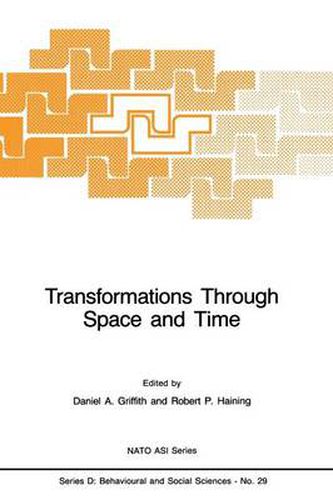Readings Newsletter
Become a Readings Member to make your shopping experience even easier.
Sign in or sign up for free!
You’re not far away from qualifying for FREE standard shipping within Australia
You’ve qualified for FREE standard shipping within Australia
The cart is loading…






This title is printed to order. This book may have been self-published. If so, we cannot guarantee the quality of the content. In the main most books will have gone through the editing process however some may not. We therefore suggest that you be aware of this before ordering this book. If in doubt check either the author or publisher’s details as we are unable to accept any returns unless they are faulty. Please contact us if you have any questions.
In recent years there has been a growing concern for the development of both efficient and effective ways to handle space-time problems. Such developments should be theoretically as well as empirically oriented. Regardless of which of these two arenas one enters. the impression is quickly gained that contemporary wO,rk on dynamic and evolutionary models has not proved to be as illuminating and rewarding as first anticipated. Historically speaking. the single. most important lesson this avenue of research has provided. is that linear models are woefully inadequate when dominant non-linear trends and relationships prevail. and that independent activities and actions are all but non-existent in the real-world. Meanwhile. one prominent imp 1 ication stemming from this 1 iterature is that the easiest modelling tasks are those of specifying good dynamic space-time models. Somewhat more problematic are the statistical questions of model specification. parameter estimation. and model validation. whereas even more problematic is the operationalization of evolutionary conceptual models. A timely next step in spatial analysis would seem to be a return to basics. with a pronounced focus both on specific problems (and data) and on the mechanisms that transform phenomena through space and/or time’. It appears that these transformation mechanisms must embrace both non-linear and autoregressive formalisms. Given. also. the variety of geographic forms. they must allow for bifurcation points to emerge. too.
$9.00 standard shipping within Australia
FREE standard shipping within Australia for orders over $100.00
Express & International shipping calculated at checkout
This title is printed to order. This book may have been self-published. If so, we cannot guarantee the quality of the content. In the main most books will have gone through the editing process however some may not. We therefore suggest that you be aware of this before ordering this book. If in doubt check either the author or publisher’s details as we are unable to accept any returns unless they are faulty. Please contact us if you have any questions.
In recent years there has been a growing concern for the development of both efficient and effective ways to handle space-time problems. Such developments should be theoretically as well as empirically oriented. Regardless of which of these two arenas one enters. the impression is quickly gained that contemporary wO,rk on dynamic and evolutionary models has not proved to be as illuminating and rewarding as first anticipated. Historically speaking. the single. most important lesson this avenue of research has provided. is that linear models are woefully inadequate when dominant non-linear trends and relationships prevail. and that independent activities and actions are all but non-existent in the real-world. Meanwhile. one prominent imp 1 ication stemming from this 1 iterature is that the easiest modelling tasks are those of specifying good dynamic space-time models. Somewhat more problematic are the statistical questions of model specification. parameter estimation. and model validation. whereas even more problematic is the operationalization of evolutionary conceptual models. A timely next step in spatial analysis would seem to be a return to basics. with a pronounced focus both on specific problems (and data) and on the mechanisms that transform phenomena through space and/or time’. It appears that these transformation mechanisms must embrace both non-linear and autoregressive formalisms. Given. also. the variety of geographic forms. they must allow for bifurcation points to emerge. too.